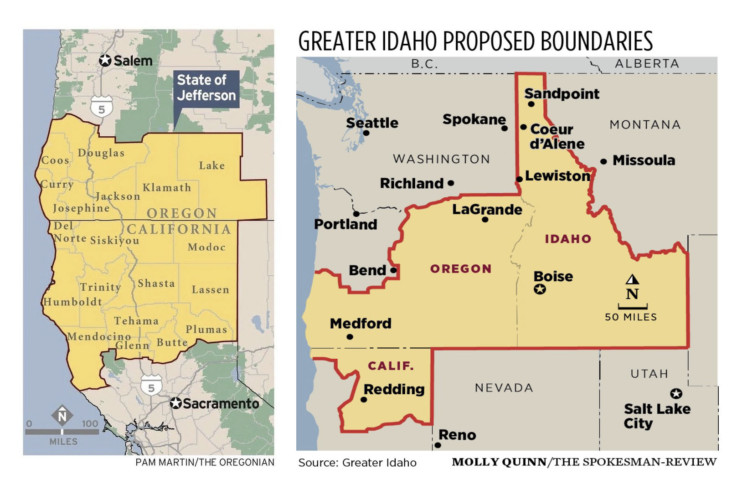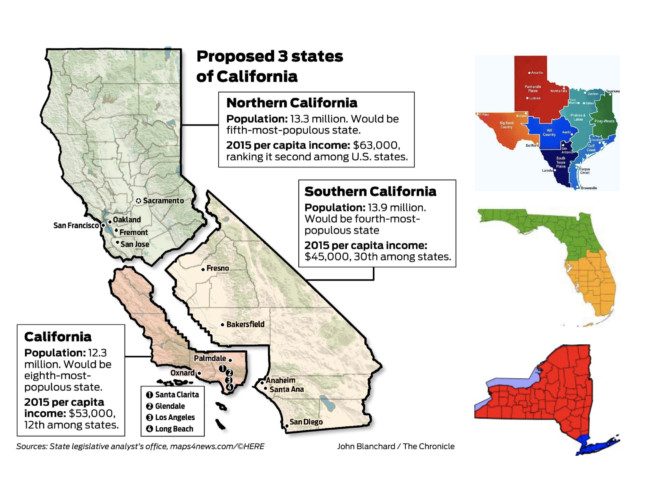
Some rural Oregonians, fed up with the liberal domination of Portland, want to secede and become part of a more politically compatible Idaho. Political columnist Noah Millman has a radically different idea – with a different purpose.
In a New York Times op-ed, Millman suggests subdividing each of America’s three “megastates” – California, Texas and Florida – into three or more smaller states. He makes the case not based on political disgruntlement, but on equalizing congressional representation across the nation.
“Since 1980, 40 percent of America’s population growth has accrued to three megastates,” Millman writes. “California has more than eight times the population of the median US state. On its own, Los Angeles County would be the 10th largest state in the union. The four largest states by population (the three megastates plus New York) now make up roughly one-third of the entire population of the entire United States – and more than the smallest 34 states combined.”
More states would mean more senators, Millman says, correcting a growing and unsustainable imbalance in the US Senate. The four largest states (one-third of the US population) have a total of eight senators. The 34 smallest states (less than one-third of the population) have 68.
The work of dividing states might not only give us the space we need from one another, but also help us learn how to cooperate again. Breaking up can be hard to do, but sometimes, it’s the best way to ultimately come together.
More senators also would influence the Electoral College. Each state’s electoral vote is determined by the number of its congressional districts plus two senators. So, if California was broken into five states, they collectively would have eight more electoral votes than now. “One reason to break up the big states is to give their citizens something closer to appropriate representation,” Millman says.
He also believes smaller states would be more manageable and could pay closer attention to regional interests and partners. That idea has occurred to others. The proposed State of Jefferson would combine portions of Southern Oregon with Northern California, which share an interest in timber, agriculture, tourism and water management.
Rules for state-splitting would need to be set to ensure they met a minimum population level and avoided balkanization, according to Millman. He thinks that still would allow creation of city states in Los Angeles, San Francisco and New York City, much like Berlin in Germany. The advantage of city states, he says, would be to allow its congressional representatives to focus on unique urban issues and coordinate with contemporary regional partners, as opposed to historic ones. The Erie Canal, Millman notes, is no longer a viable economic or political link.
Adding more senators (congressional districts would remain apportioned by population) has obvious political ramifications. However, Millman thinks subdividing the three megastates, two of which are considered red states, wouldn’t necessarily accrue benefits to Democrats. He points to Florida, which if broken into three states, would have a solidly Republican state in the north, a Democratic-leaning state in the south and a swing district in Central Florida. California and Texas have similar red and blue regions.

More important, Millman insists, is the division could reduce partisan resentments within states. Of course, those urban-rural divides also exist in smaller states as well as large ones, as evidenced by the secession drive in parts of rural Oregon to become part of “Greater Idaho”.
There are lots of hurdles to carving up or realigning states, but there is precedent – and constitutional guidance. Kentucky was formerly part of Virginia, Tennessee separated from North Carolina and Maine sprung from Massachusetts. A total of 37 new states have been admitted from the original 13 colonies-turned-states. The latest additions are Alaska and Hawaii in 1959. Puerto Rico and the District of Columbia are seeking statehood.
The Admissions Clause of the US Constitution contained in Article IV, Section 3 grants Congress the power to admit states, though it provides thin guidance on how to admit them. The history of statehood is rife with political deal-making. Missouri and Maine were admitted as a pair. Effectively, so were Alaska and Hawaii. Washington joined the Union in 1889, along with North Dakota, South Dakota and Montana.
Admitting new states was a contentious pre-Civil War issue centered on whether new states would allow or outlaw slavery. The Compromise of 1850, which delayed the Civil War by a decade, admitted California as a Free State while approving the Fugitive Slave Law that allowed slaveowners to recover runaway slaves. Southerners went along with the deal even though it tipped the delicate political balance in the Senate because of the promise of California’s gold rush. Oregon became a state in 1959, just before the start of the Civil War. When the Civil War broke out, West Virginia effectively seceded from Virginia to form a pro-Union state, which Congress admitted “assuming” Virginia’s consent.
Sentiment and iconic logos of the current shapes of states may deter some from considering Millman’s idea. But pragmatic politics, sectional interests and citizen preferences might prevail, as it has in the past. If nothing else, Millman has offered a suggestion to resolve growing resentment over unequal representation in Congress and the Electoral College in a trademark American way. While the logistical details of state-splitting would be mind-numbing, Millman’s concept is politically conceivable and possibly palatable to Democrats and Republicans, as opposed to eliminating the Electoral College or fiddling with the filibuster.
Re-aligning and splitting up states may seem like a crackpot notion today, but its potential political appeal may move it into mainstream consideration. After all, there is widespread evidence Americans already vote with their feet, moving to states and communities to work, enjoy a lifestyle and feel a kindred political spirit with their neighbors. Politicos in California and New York, and possibly other states as well, have already looked at, studied or tried to put some form of state-splitting on a ballot.
Millman thinks breaking up bad relationships and forming healthier new ones could be a tonic for a deeply divided nation. “It sometimes seems the United States is flying apart into mutually hostile factions. The genius of our federal system is that it provides a framework for a multiplicity of communities, with different interests and values, to live together as part of a single country. If that system feels as though it’s breaking down, maybe it’s partly because its components are out of balance. The work of dividing states might not only give us the space we need from one another, but also help us learn how to cooperate again. Breaking up can be hard to do, but sometimes, it’s the best way to ultimately come together.”





